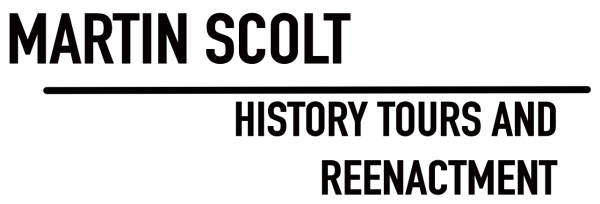Day 1, August 4th
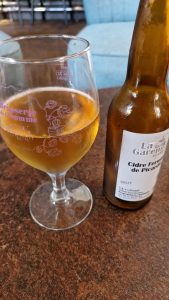
After a night of little restful sleep and after packing the last of my things in the car, I get in the car at 8:00 a.m. on my way to Maastricht. I have a cup of coffee at my parents’ house and, after putting my mother’s things in the car, we drive around 10:45 a.m. towards the Somme in France. A quick stop for something to eat and drink along the way, and we’re on our way again. Along the way, we enjoy the scenery, which becomes increasingly beautiful as we get closer to our destination. Hills here, a beautiful church there. Around 2:30 p.m., we arrive at the hotel and check in.
We’re staying at Cap Le Hornu, a three-star hotel. But everything looks impeccable. A quick check-in to the room and then it’s off to the bar for a well-deserved French cider. My stomach starts rumbling terribly, so we quickly finish our drink and head towards the village center. Of course, we take some time to look around and see all the beautiful things they’ve built, and I quickly notice that, unlike in Normandy, everything here looks a bit older. I find it quite remarkable because everything in Normandy is pre-World War II, while here in the Somme region, it feels more like it was built during World War I. This is partly what the area is known for.
Anyway, I quickly watch the steam train pull in, and then it’s on to the restaurant where I eat delicious mussels and my mother has a shrimp salad. The beers here are also very good, by the way. After dinner, we’ll take a stroll through the old part of the village and then head back to the hotel. We’ll read a bit, write a story, and then head to bed for a long, packed second day.
Day 2, August 5th
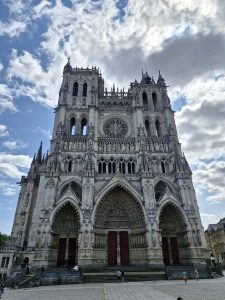
After a wonderful night’s sleep, day two dawned. I woke up again during the night to use the restroom, and because the hotel room window was open, I could see the village lights across the bay. A beautiful view. We got ready, and around 8:30 a.m., we got in the car to look for a bakery. We had the option of adding breakfast for 18 euros per person per day, but nothing beats fresh rolls from a French bakery. After buying a croissant, two chocolate biscuits, and a small baguette, we headed to the Samara open-air museum, about an hour’s drive from the hotel. I quickly realized it would be better to take a sweater with me.
Upon arrival, it was already incredibly crowded with a school group of children, and the museum shop wasn’t very well received. We drove on to the ruins of Picquigny Castle, and I noticed that there were bullet holes in the walls here and there: probably from the First World War. Despite the sun, the wind was still chilly, and I decided that if we came across a Decathlon store, I’d buy a sweater. We continued our way to Amiens to visit the cathedral, which actually turned out to be a basilica. A truly beautiful building built sometime around 1200. It was getting close to lunchtime, so we looked for a restaurant to eat something.
After lunch, we got back into the car. I still had no sweater, and slowly drove back in the direction of the park and a Sauna. It was there that we learned is that it was far too crowded. But, you see, there’s still a lot more to see and do. On the way back, in the direction of the hotel, we took a look in the ruins of the castle of Pont Remy and at the crashsite of a B17, which is on the 22nd of June, 1944 was crash-landed in the nearby area. Nearly the whole of the crew are dead except for 1, which ended up as a POW (prisoner of war). Back on the road we drove on to find a brocanterie, but it was not to be found. Then it went back to the hotel to finally do a pull up, and we drove out to the place of Cayeux-sur-mer, where we had some cider to drink.
I have my appetite back, and we’re in the village, next to the hotel and go to dinner. After dinner, we went back to the hotel, and I thought it would be a good idea to do a review, to shoot a video for my youtube channel about my First World War uniform that I had brought with me. So I’m at various locations to take a video on what happened to the place since 1916, during the battle of the Somme but I found out that I left my shoes and beenwindsels home. Bummer. Another beer in the hotel room and then off to bed early for a day dedicated to First World War locations!
Day 3, August 6th
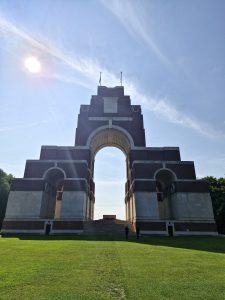
Just before the alarm went off, I woke up. A new day, the hum of a paraglider flying over the bay, the sheep in the meadow behind our hotel. Living like a god in France. Now, I’m not a god, but I am living in France this week. We had a long day ahead of us; I wasn’t fully aware of that yet, though. The end of the day would tell a different story.
We got in the car just before 9 a.m. and headed for Peronne, a town a two-hour drive from the hotel. Along the way, we thoroughly enjoyed the surroundings. When we got close to our destination, we popped into the supermarket first, as it was almost 11 a.m. and time for a bite to eat. With a full bag, we drove on to Peronne Castle and sat on a bench to enjoy our breakfast. Next, we went into the castle, which also housed a World War I museum. Win-win. Afterward, we quickly raided the museum shop and, with five new books in hand, set off to explore the rest of the castle. But that was all done in a flash. Then I wanted to pop into the museum shop at the “Musee Somme 1916,” a tunnel several hundred meters long with displays in the alcoves. We’d been there last year, but I really wanted to buy an original British cap badge for my uniform.
We couldn’t remember Albert Church, so we popped in there for a quick look around. Afterward, it was definitely time for a glass of cider. With a delicious glass under our belts, we headed back to the car and continued our journey to Lochnagar Crater. By tunneling under the German trenches, the British had planted explosives, and on July 1, 1916, the whole thing blew up. The result was a scar some 20 meters deep and 50 meters wide in the earth. Here and there around the memorial, photos were visible, along with eyewitness accounts. A very impressive sight (and more to come that day) was the journey from Lochnagar Crater to the Australian Animal Memorial, which honors the nine million animals that perished during the war. This memorial was erected by the Australians who served in that area.
After filming some footage for the YouTube channel, we drove on to the Thiepval Museum and Memorial. Although the museum itself wasn’t very large, there was a wealth of information, and behind the museum lies the imposing monument. It lists the names of some seventy thousand men who died during the five months of the Battle of the Somme. From the monument, it was a short seven-minute drive to the final monument, and in my opinion, the most remarkable of the day: the Beaumont Hamel Newfoundland Memorial. A beautiful site where both the craters and trenches are still clearly visible. A rock with a bronze caribou has been placed there, and plants and trees from Canada adorn it. Even though the visitor center was closed, I ended up spending about forty-five minutes wandering around and trying to see as much as possible.
Our feet were starting to get sore from all the walking we’d done that day, but first we had to walk an hour and a half back on back roads to the village where our hotel is located. We finished the evening at a restaurant where we had skate and fish soup, washed down with a few glasses of cider. As soon as I get home, I can start editing the videos, which will be available on my YouTube channel.
Day 4, August 7th
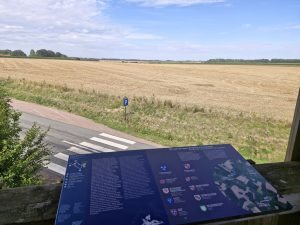
As the sun begins to shine through the open window, I cautiously open one eye. I hadn’t heard my alarm go off yet, so I decided to wait until it did. Since yesterday was a long day, I decided to take it a bit easier today. The area around Agincourt was on the agenda. Another hour’s drive from the hotel. After getting ready, we got in the car and drove slightly northeast. After a little over an hour’s drive, we arrived in the village.
If you had said in the morning, we would be so blessed to have it. Not chicken out on the streets. It is a view into a local bakery and disappeared, therefore, as snow before the sun. First, we made our way to the meadow, where the actual battle took place. Today, there is little to be seen on some signs, wooden uitkijktorentje, and a stone after it. After you have all the information they have read (in both French and English is below), take a closer look was taken from the tower. A card and you get a pretty clear picture of what the battlefield, there was, at that time, looked like it should have.
After visiting the meadow, we drove on to the museum. We bought a nice bottle of wine in the shop and browsed around, before exploring the exhibition. A wealth of information, a mix of French and English, and an unpleasant gnawing hunger pang didn’t help us concentrate enough to extract the most interesting information. So we quickly browsed the museum and drove to a slightly larger town less than 10 minutes away in search of breakfast.
We stumbled upon a rather obscure-looking café via Google Maps, and the reviews indicated the food was excellent. The bartender took our order and walked across the street to presumably have his mother or partner prepare our food. And lo and behold, it was truly delicious! We both had a “Welsh Complete,” which consists of a beer and cheese sauce, two toasted sandwiches, and a few slices of ham. It was topped off with a gratin, and I had a fried egg. All of this was rounded off with a basket of golden fries. Not your typical breakfast, but a pleasant way to fill your stomach.
We continued our journey towards Château Fressin, a large ruin of what was once a mighty castle. After exploring for about 45 minutes, we headed towards Le Crotoy, a coastal town across the bay from our hotel. On the way there, we found a second-hand shop where, unfortunately, there was nothing of interest. Arriving in Le Crotoy, we quickly settled down on a terrace to enjoy some ciders. We then took a stroll along the beach to kill some time before driving back towards the village where our hotel is located to eat at the same restaurant we had been at last night. After filling our bellies, we finished the day in our hotel room by reading and having another beer. Tomorrow, after two years, we can finally visit the castle and museum in Dieppe.
Day 5, August 7th
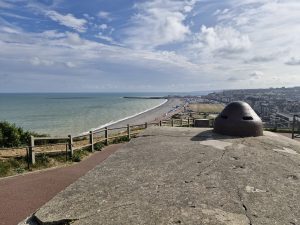
At 7:30 sharp, the alarm goes off. On vacation? Yes, on vacation, this time there’s an alarm. Shower, get dressed, pack your things, and get in the car for a good hour’s drive to Dieppe. Along the way, we stop at a traditional boulangerie for a delicious breakfast sandwich. Then on we go, and around 10:50, we arrive at the imposing castle overlooking the city. We were here in 2023, but it was closed then, and since we’re in the area this time, we just have to take it.
The castle itself dates back to the 15th century, but to my regret, there are only paintings and the occasional model ship and ivory carvings on display. Where are the armor, swords, and throne? Well, a painting every now and then is certainly a sight to behold. Meanwhile, I was already immersing myself in information about Operation Jubilee, which took place on August 19, 1942. So, afterward, we set off to look for the monuments. Since the museum didn’t open until 2:00 PM, I initially focused on filming a few snippets for a new YouTube video. By then, it was almost noon, and it was high time for a light lunch with a glass of cider. It’s still a holiday, after all.
We also saw two churches we were going to visit to kill time. France doesn’t seem to take very good care of its monumental buildings, and the churches looked a bit dilapidated. It’s two o’clock, and I walk to the museum. It’s located in an old theater, the kind you see in movies, with a balcony and a beautifully painted ceiling. Upon entering, we were told a film about the events of the raid was playing; so the first forty-five minutes were already full. After the film, we walked around the rest of the museum. It was a small exhibition, but it contained a wealth of original photos, stories, and the necessary equipment the men wore back then.
After the museum, we continued our way to the local cemetery. But first, we popped into a second-hand shop along the way and bought some items for home. Arriving at the cemetery, we filmed another segment for the video and took a moment to stroll past the graves and commemorate the brave men. Lest we forget. Time flies, and it’s almost dinnertime, so we set off in search of a restaurant. We arrived back in the center of Dieppe and settled into a building that could have been straight out of a German village. Fish and chips, lasagna, and a few glasses of cider later, we were back outside to begin our journey back to the hotel. An interesting day dedicated to Operation Jubilee. Tomorrow we’ll head home, but not before visiting the Calais bunkers. Good night.
Day 6, August 8th, the end
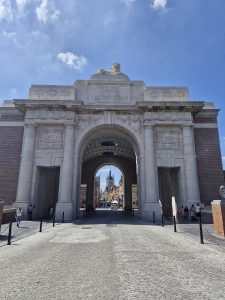
I’d been awake for an hour, trying to get some sleep, but I was still agonizing, thinking our last day was already upon us. First things first: get up, shower, and pack up our things. After putting everything in the car, we checked out at the reception desk. It was sad to leave that beautiful, peaceful place with its stunning views behind us. But the day was young, and the road was long.
Off to Calais. We’d been on the road for half an hour when hunger started to grow and we managed to get something French for breakfast for the last time. A bacon and onion baguette and a piece of flan later, we were on our way again. Or wait? Wasn’t the trip supposed to be about seeing World War I sites? We’re near Ypres now anyway. Turn around and head in a different direction.
Two hours later, we arrive at the site of “Hill 60,” an old battlefield where the Australian 1st Tunnel Company dug a full 700 meters underground towards the German trenches to plant 32,000 kilograms of explosives. Today, a large crater is visible, and it also serves as a cemetery for the Germans buried under thousands of kilograms of earth. However peaceful it may be now, I always try to imagine what it must have been like back then. It leaves you speechless.
We continue our way to the Hill 62 museum a few kilometers further on. This museum still has trench craters and piles of scrap metal from the First World War in its garden. Although the museum could certainly use an update, it’s still impressive to see where the Allies were in the trenches, and you get a sense of what it must have looked like back then.
Time for a delicious lunch. In the city of Ypres, we searched for a small pub with finger food. We had tomato soup, a toasted sandwich, and some calamari, all washed down with cider. I can’t get enough of it. After dinner, we took a look at the old Cloth Hall, which was completely destroyed during the First World War and completely rebuilt in the years afterward. The people of Ypres did a fantastic job. Unfortunately, there was a fair going on, so we couldn’t see the Cloth Hall in all its glory. All the more reason to go back.
Home was still two hours away, so after buying a souvenir, we went back to the car where, to my dismay, I discovered a 25-euro souvenir for illegal parking under my windshield wiper. I’ll have to pay that first when I get home tonight.
Six days later, I can only look back on the holiday with immense satisfaction. We did so much, and the days were long. But long, wonderful, and educational. My hunger to learn more about the First World War has only grown, and I even ordered a book to learn more about the Battle of Agincourt in 1415. I can’t wait for my next trip. When I get home, I have a lot of work ahead of me editing all the footage from the trip for my YouTube channel. Stay tuned, as it will be online in the coming weeks.
